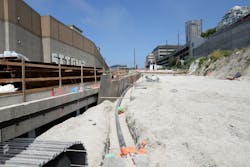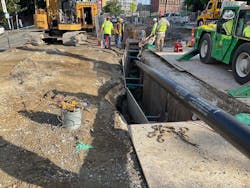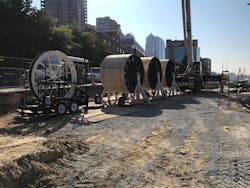Powering the Heart of Seattle
Project Overview
The transmission relocation project included the installation of about 2,165 feet of high- pressure fluid-filled (HPFF) pipe type cable in an 8.625 inches OD by 1/4-inch-inch thick steel pipe that is coated with 60 mils of extruded polyethylene. The new line section ran down Alaskan Way, connecting to the pre-existing line in a vault on Pike Street and another one north of Elliott Way and would run parallel to the pre-existing line.
Relocating the transmission line was necessary to construct the elevated roadway at Elliott Way west of the historic Pike Place Market in downtown Seattle. The existing line was to be maintained in place while the new transmission line was constructed. Planning for the project began in 2013, dating back to the construction of the SR 99 Tunnel, the demolition of the Alaskan Way Viaduct and the reimagining of the waterfront. The transmission lines powering downtown Seattle had hung suspended under the Alaskan Way viaduct from 1953 to 2017, an unassuming set of pipes that transported the power that lit up the city skyline.
Full relocation and undergrounding of these transmission lines began in 2008, and the Central Waterfront Transmission Line Relocation Project had to be finished before the planned Waterfront Seattle Program could begin, connecting downtown to the newly renovated waterfront. The project’s first phase was completed in 2012 with the relation of a section of lines between Yesler Way and Union Street substation. The second phase, which was temporarily paused by the SR 99 Tunnel Project, undergrounded lines from South King Street to Yesler Way, setting the stage for more waterfront redevelopment in the heart of the city.
Another challenge of relocating the transmission line was its proximity to the Burlington Northern Santa Fe (BNSF) Railroad line that runs through the area. According to the project's scope, 239 linear feet of the pipe were to be supported under a bridge that crosses the BNSF Railroad line. Seattle City Light contracted the firm Power Engineers to engineer the project. For Adam Smith, Underground Transmission Engineer for Power Engineers, designing around the bridge was one of the more unique aspects of this project.
"We used a non-traditional method and supported the 8” steel cable pipe below the deck of the bridge," Smith said. "Since it was a high-pressure pipe type cable, the line needed to stay in place while being able to withstand possible seismic activity along with the expansion and contraction of the bridge itself. We designed a pipe support system under the bridge with sliding stands and included offset bends in the pipe to allow movement in the pipe in the event of an earthquake."
HPFF Cable Procurement and Protection
Procuring a 115kV HPFF cable isn't as simple as picking it up from a warehouse. For this project, City Light had UTEC Constructors Corp in Boston, who specializes in HPFF cable system installation, order the cable at least a year in advance. For the relocation to begin, UTEC needed to install vaults at two points to cut into the existing line.
The pipe is filled with pressurized dielectric fluid which increases the dielectric strength of the paper cable insulation to ensure it does not fail when the line is operated at high voltages. To prevent the fluid from leaking out of the line when it was cut into at the tie-in vaults for relocation, the dielectric fluid inside the pipe needed to be frozen. This "freezing" stage was critical to ensure that the project remained on schedule.
The team from UTEC began by removing the external coating of the pipe down to the steel. Then, they wrapped copper pipe around the line and filled the pipe with liquid nitrogen to accelerate the freezing process, which roughly takes eight to nine hours. Because of the angle of the line in some areas, the team had to use a vacuum truck to remove any excess oil remaining in the line to prevent any potential spills. This work was done while maintaining the minimum allowable pressure of 50 pound-force per square inch at the high point of the circuit. A pressure gauge was also installed at the remote end of the circuit to monitor the line's pressure. Once the line was frozen, the team could begin the cutover process.
Precise Offline Window
While the location of the transmission line was in the center of one of the most significant improvements to Seattle's landscape in decades, its importance to the Western US Power System also added to the pressure of the flawless execution of this project. Because of this, the transmission line is only taken offline only twice a year during off-peak load seasons. Due to Western US Power System regulations, the team had to submit the request 365 calendar days before the outage, specifying the electrical boundaries, the date the outage would begin and the date the City Light facilities could be energized and put into service. Their deadline: October 31, 2021. For Seattle City Light Senior Project Manager Mike Fernandes, and the Waterfront Seattle team, there was minimal room for error.
“We had a narrow window for the transmission line to be offline. Missing our window would have delayed the construction of the waterfront for six months, so we prepared for as many variables as we could think of. We had multiple pre-construction meetings to ensure everyone knew their role when it was go time,” Smith said.
The complexity of the tasks at hand and the encroaching in-service dates of the project meant that all involved in construction, engineering and procurement needed to coordinate their efforts carefully, Smith said.
"It was a tight window," Smith said. "Everybody needed to be on the same page if we were going get this right."
Finally, the line arrived on large reels, and it was time to get to work. The team relocated the 2,200 feet of transmission line successfully and seamlessly within their limited time window. The team pulled out the old cable from the section of existing pipe between the freeze points and the new cable was pulled into the new pipe section. The pipe was then filled with new dielectric fluid and the system the was hermetically sealed to keep any other liquid or moisture out. Finally, the freezes were released, and the line was pressured and re-energized. With the project complete, the construction of Seattle's new waterfront could continue without delay.
Other Challenges
Like most projects completed during the pandemic, the transmission relocation project had its share of challenges and potential pitfalls. Due to the time of the project in fall 2021, getting the specialized oil for the line from eastern Canada was a challenge and took much longer than usual. Though it could have potentially delayed the project, UTEC was able to get the dielectric fluid in time for the outage.
Another potential difficulty for this project was Seattle’s notorious rainfall. However, to the surprise of project planners, transmission cable work wasn't delayed a single day due to rain or inclement weather.
Lighting Seattle
A new pedestrian bridge, now no longer carrying a transmission line, has arisen in place of the old at Marion Street. A new Pier 58, to be known as Waterfront Park, is being built with families and children in mind, with plazas and playgrounds. The pier will offer views of the picturesque Olympic Mountains on clear days and vistas across Elliott Bay. The new pier is also engineered to help the marine habitat by letting more natural light through, helping aquatic plants grow to provide habitat and food for ocean life. Public art and fountains will also add life to the area.
None of these new features would be possible without a steady flow of electricity into downtown Seattle, which this project will ensure for many years to come. Andy Vena, Project Manager for UTEC, said the relocation was a success thanks to the collaboration of entities such as Power Engineers, Seattle City Light, as well as the Seattle Department of Transportation, Jacobs, HNTB, WSP and Gary Merlino Construction Company, Inc.
"There was great coordination between the teams," Vena said. "It helped that City Light had a knowledgeable team who could be more of a partner than a client throughout the entire process. The pipe cable that we used is the standard in our field and, with the right team, can be installed properly and efficiently."
Mike Fernandes is senior project manager for Seattle City Light, a municipally owned power company, serving more than 345,000 residential, commercial, industrial, and government customers in their 131.3-square-mile Settle Washington, serviced area.
Nathan MacDonald is a senior public relations specialist for Seattle City Light. After graduation from Florida State University in 2012, with a M.S. in Integrated Marketing Communication, Nathan’s career has included marketing, public relations, and other communication-related responsibilities.
About the Author
Mike Fernandes
Mike Fernandes is Senior Project Manager for Seattle City Light, a municipally owned power company, serving more than 345,000 residential, commercial, industrial, and government customers in their 131.3-square-mile Settle Washington, serviced area.
Nathan MacDonald
Nathan MacDonald is a Senior Public Relations Specialist for Seattle City Light. After graduation from Florida State University in 2012, with a M.S. in Integrated Marketing Communication, Nathan’s career has included marketing, public relations, and other communication-related responsibilities.






